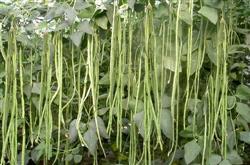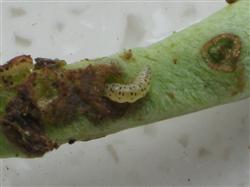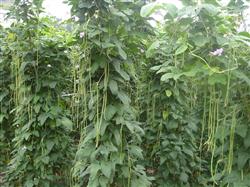How can you grow beans in autumn with high yield?

How do you grow beans in autumn? Please introduce planting methods Autumn planting beans can refer to the following methods: First, variety and soil selection. Autumn beans planting should choose cold resistance, moisture resistance, strong ability to turn over the beans varieties. The soil should choose the sandy loam with higher terrain, deep soil layer, good drainage, moderate pH and no legume crops. 2. Timely sowing and reasonable close planting. Autumn beans should be selected in August to September sowing. Direct seeding is the best way to sow seeds. Reasonable close planting, seed amount per mu 1.25~1.5 kg, row spacing 50~60 cm, plant spacing 8~10 cm, double row planting, 2 seeds per hole. 3. Field management. 1. Insert bamboo lead tendril: general seedlings grow to 30~40 cm when insert bamboo lead tendril. The vines should be introduced in cool weather on sunny days, and it is appropriate to introduce about 4 vines per hedge bamboo. 2. Fertilizer and water management: bean fertilization should be based on base fertilizer, supplemented by topdressing. 1500 - 2000 kg of high-quality soil miscellaneous fertilizer and 20 kg of compound fertilizer are applied to the base fertilizer when the base fertilizer is combined with the ridge, and 30 - 40 kg of Xingwang fruit vegetable compound fertilizer is applied to both sides of the ridge when the base fertilizer is combined with the soil cultivation at the initial flowering stage. Topdressing should be applied thinly at seedling stage, gradually increasing fertilizer concentration with plant growth, and topdressing should be carried out in sunny days every time. During the harvest period, depending on the growth, topdressing should be applied as appropriate. Beans in the whole growth period are taboo wet, soil too wet easy to cause excessive growth or rotten roots, especially after sowing soil too wet, seeds absorb too much water and sprout too early, so that the tissue of seedlings delicate, stress resistance can be weakened, easy to cause excessive growth or dead seedlings. Therefore, sowing should be carried out on sunny days, and before sowing, water should be drenched between sowing rows before sowing, and water should not be drenched within 2 to 3 days after sowing. When the seeds begin to emerge, appropriate amount of water is beneficial to the growth and health of seedlings. Flowering and pod bearing require more water, especially in autumn when the temperature is high, water evaporation is large, early and late to sprinkle water to adjust the field microclimate. IV. Pest control. Bean diseases mainly include root rot and rust. Rootrot should be treated by rotation system and field management according to the principle of "prevention first and control combined". At the same time, 50% carbendazim 1kg + fine soil 400~ 500kg should be mixed evenly before sowing. At the initial stage of disease, 37% root rot 200~300 times solution or dixon 1000~1500 times solution should be used to drench roots once every 3~5 days for 2~3 times continuously. Rust can be sprayed with 200~250 times solution of colloidal sulfur or 15% triadimefon WP 150~200 g mixed with 75~80 kg water. The pests mainly include pod borer and cowpea pod borer, which can be sprayed once every 7~10 days from budding to early flowering stage for 2~3 times continuously with 500 times of 25% bisultap or 50~ 75g of kasik mixed with 60kg of water. Click for more bean growing techniques Click for more vegetable growing techniques
- Prev

How to prevent and cure the heart bug by planting beans?
How to prevent and cure the heart bug by planting beans? Please introduce the method of bean borer, also known as cowpea borer, is one of the main pests of beans. Cowpea borer adults are scattered and hidden, fly to lay eggs in a wide range, lay a large number of eggs, it is not easy to spray or trap. The adults lay eggs in the tender leaves of the plant, and after about 5 mi mi hatched for 7 days, the worms entered.
- Next

How to prevent and cure rust by planting beans in autumn?
How to prevent and cure rust by planting beans in autumn? Please introduce the prevention and control methods of planting beans in autumn with high temperature and more rainfall, coupled with the large bacterial source (summer spores) of beans planted in spring in the field. Therefore, beans planted in autumn are prone to rust, and farmers should carry out comprehensive control as soon as possible. First, the main symptoms: whole beans.
Related
- Where is it suitable to grow horseradish in China? it is expected to see the middle altitude horseradish in Alishan.
- How to prevent tomato virus disease reasonably? (Control methods included)
- Many people like to plant towel gourd on the balcony. What are the main points of this method and management?
- What crops can chili peppers be mixed with?
- Fertilization techniques and matters needing attention in Tomato
- What are the grafting techniques for peach seedlings in spring?
- Harm and control methods of root swelling disease of Chinese cabbage
- What are the pests of sweet potatoes? How to prevent and cure it?
- Symptoms, causes and Control methods of navel Rot in Tomato
- The cause of "Cucumber rotten bibcock" in Farmers' planting Cucumber and its Control Plan

